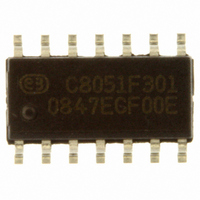C8051F301-GS Silicon Laboratories Inc, C8051F301-GS Datasheet - Page 72

C8051F301-GS
Manufacturer Part Number
C8051F301-GS
Description
IC 8051 MCU 8K FLASH 14-SOIC
Manufacturer
Silicon Laboratories Inc
Series
C8051F30xr
Specifications of C8051F301-GS
Program Memory Type
FLASH
Program Memory Size
8KB (8K x 8)
Package / Case
14-SOIC (3.9mm Width), 14-SOL
Core Processor
8051
Core Size
8-Bit
Speed
25MHz
Connectivity
SMBus (2-Wire/I²C), UART/USART
Peripherals
POR, PWM, WDT
Number Of I /o
8
Ram Size
256 x 8
Voltage - Supply (vcc/vdd)
2.7 V ~ 3.6 V
Oscillator Type
Internal
Operating Temperature
-40°C ~ 85°C
Processor Series
C8051F3x
Core
8051
Data Bus Width
8 bit
Data Ram Size
256 B
Interface Type
I2C/SMBus/UART
Maximum Clock Frequency
25 MHz
Number Of Programmable I/os
8
Number Of Timers
3
Maximum Operating Temperature
+ 85 C
Mounting Style
SMD/SMT
3rd Party Development Tools
PK51, CA51, A51, ULINK2
Development Tools By Supplier
C8051F300DK
Minimum Operating Temperature
- 40 C
Package
14SOIC
Device Core
8051
Family Name
C8051F30x
Maximum Speed
25 MHz
Operating Supply Voltage
3.3 V
Lead Free Status / RoHS Status
Lead free / RoHS Compliant
For Use With
770-1006 - ISP 4PORT FOR SILABS C8051F MCU336-1444 - ADAPTER PROGRAM TOOLSTICK F300336-1319 - REFERENCE DESIGN STEPPER MOTOR
Eeprom Size
-
Data Converters
-
Lead Free Status / Rohs Status
Lead free / RoHS Compliant
Other names
336-1536-5
C8051F300/1/2/3/4/5
8.3.
The CIP-51 includes an extended interrupt system supporting a total of 12 interrupt sources with two prior-
ity levels. The allocation of interrupt sources between on-chip peripherals and external inputs pins varies
according to the specific version of the device. Each interrupt source has one or more associated interrupt-
pending flag(s) located in an SFR. When a peripheral or external source meets a valid interrupt condition,
the associated interrupt-pending flag is set to logic 1.
If interrupts are enabled for the source, an interrupt request is generated when the interrupt-pending flag is
set. As soon as execution of the current instruction is complete, the CPU generates an LCALL to a prede-
termined address to begin execution of an interrupt service routine (ISR). Each ISR must end with an RETI
instruction, which returns program execution to the next instruction that would have been executed if the
interrupt request had not occurred. If interrupts are not enabled, the interrupt-pending flag is ignored by the
hardware and program execution continues as normal. (The interrupt-pending flag is set to logic 1 regard-
less of the interrupt's enable/disable state.)
Each interrupt source can be individually enabled or disabled through the use of an associated interrupt
enable bit in an SFR (IE-EIE1). However, interrupts must first be globally enabled by setting the EA bit
(IE.7) to logic 1 before the individual interrupt enables are recognized. Setting the EA bit to logic 0 disables
all interrupt sources regardless of the individual interrupt-enable settings.
Note: Any instruction that clears the EA bit should be immediately followed by an instruction that
has two or more opcode bytes. For example:
// in 'C':
EA = 0;
EA = 0;
; in assembly:
CLR
CLR
If an interrupt is posted during the execution phase of a "CLR EA" opcode (or any instruction which clears
the EA bit), and the instruction is followed by a single-cycle instruction, the interrupt may be taken. How-
ever, a read of the EA bit will return a '0' inside the interrupt service routine. When the "CLR EA" opcode is
followed by a multi-cycle instruction, the interrupt will not be taken.
Some interrupt-pending flags are automatically cleared by the hardware when the CPU vectors to the ISR.
However, most are not cleared by the hardware and must be cleared by software before returning from the
ISR. If an interrupt-pending flag remains set after the CPU completes the return-from-interrupt (RETI)
instruction, a new interrupt request will be generated immediately and the CPU will reenter the ISR after
the completion of the next instruction.
8.3.1. MCU Interrupt Sources and Vectors
The MCUs support 12 interrupt sources. Software can simulate an interrupt by setting any interrupt-pend-
ing flag to logic 1. If interrupts are enabled for the flag, an interrupt request will be generated and the CPU
will vector to the ISR address associated with the interrupt-pending flag. MCU interrupt sources, associ-
ated vector addresses, priority order and control bits are summarized in Table 8.4 on page 74. Refer to the
datasheet section associated with a particular on-chip peripheral for information regarding valid interrupt
conditions for the peripheral and the behavior of its interrupt-pending flag(s).
72
EA
EA
Interrupt Handler
// clear EA bit
// ... followed by another 2-byte opcode
; clear EA bit
; ... followed by another 2-byte opcode
Rev. 2.9










